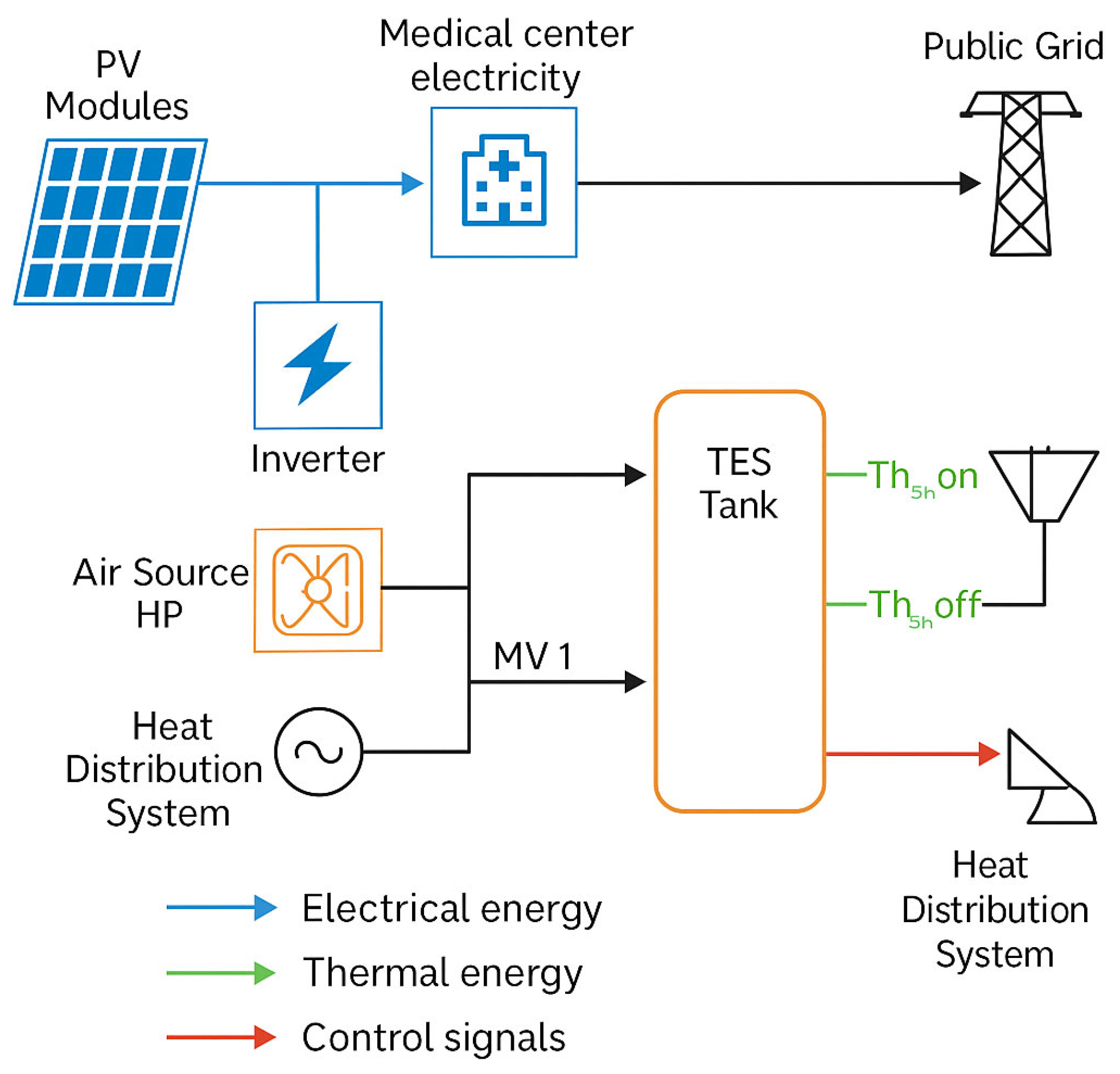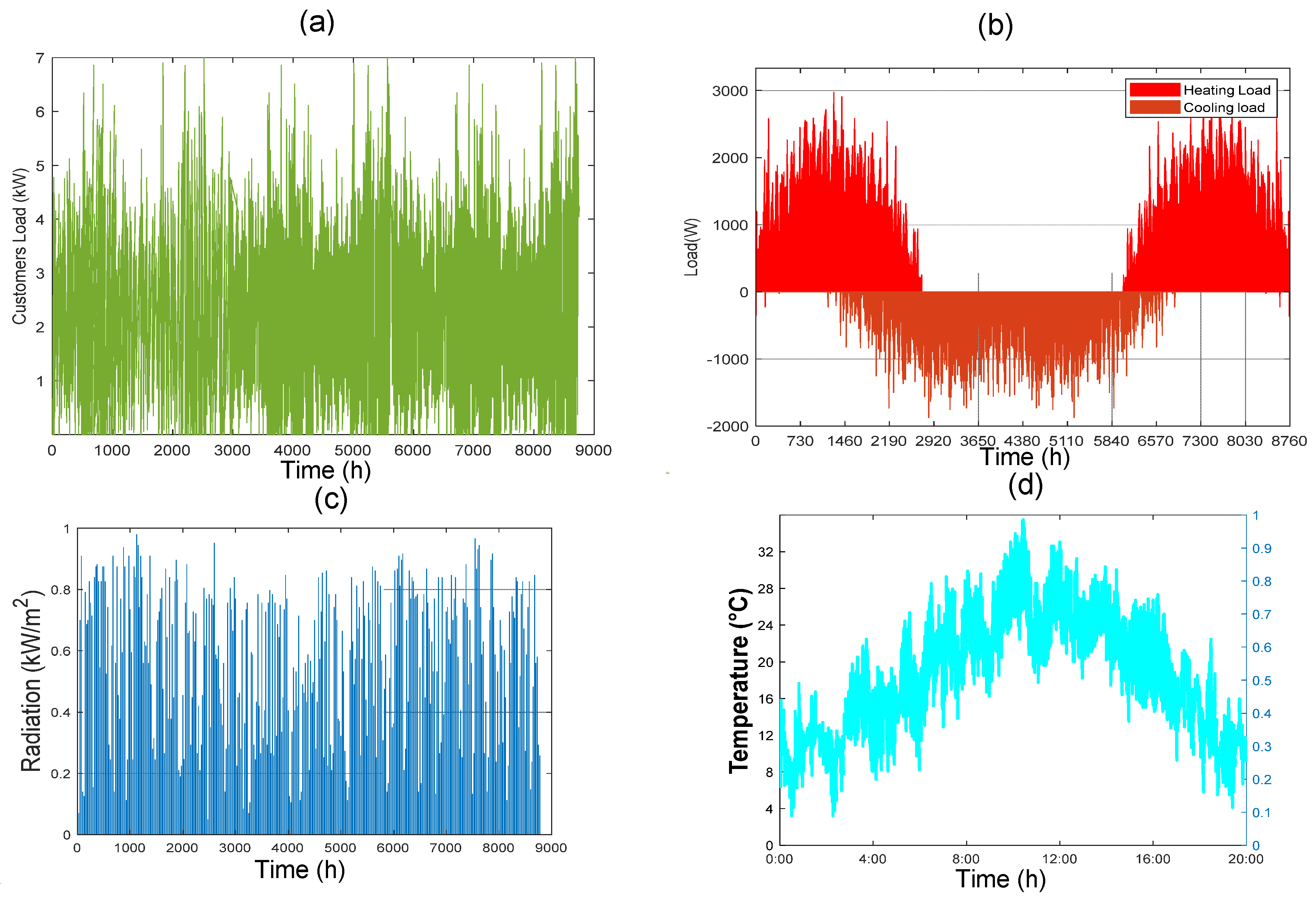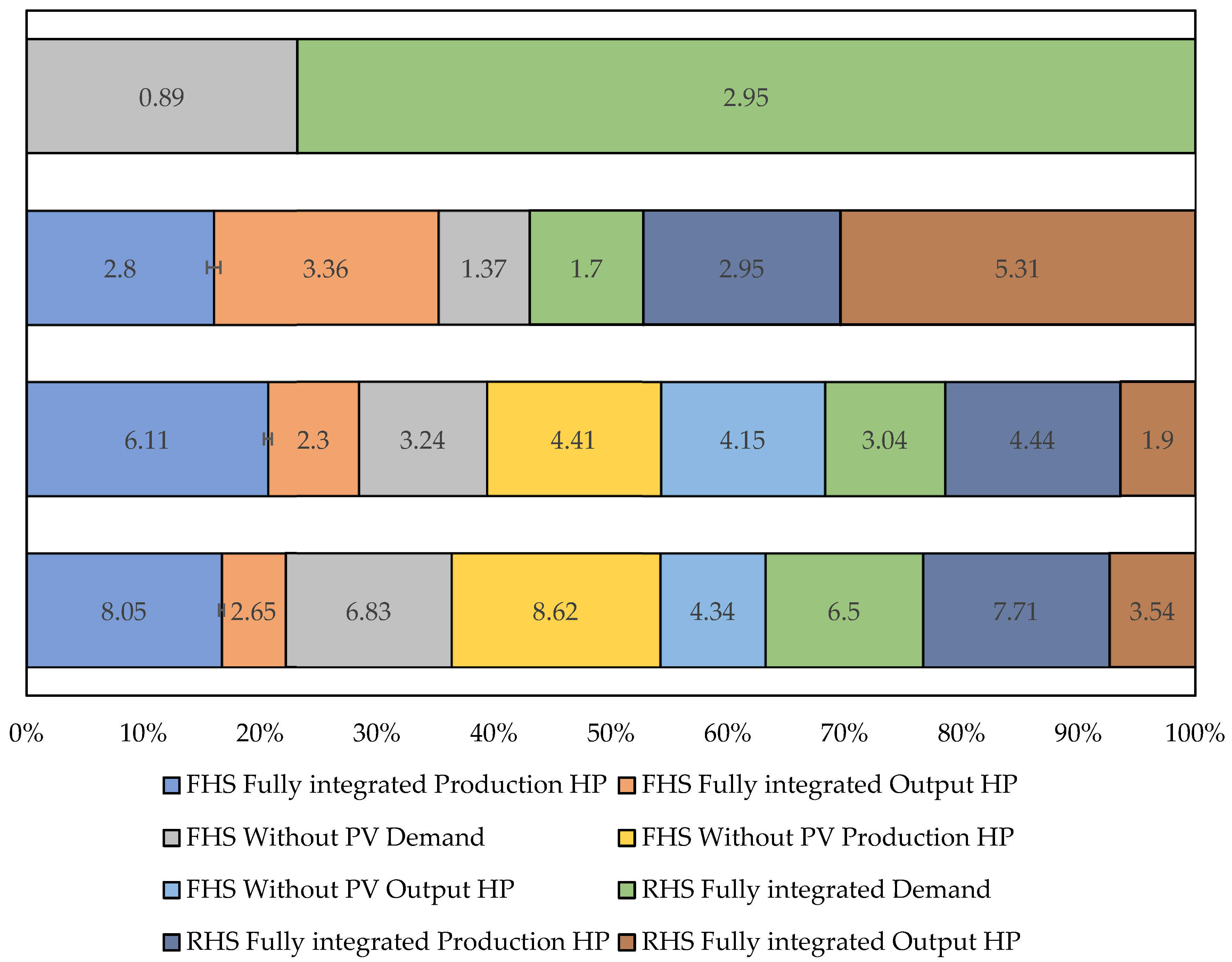Techno-Economic Analysis of an Air–Water Heat Pump Assisted by a Photovoltaic System for Rural Medical Centers: An Ecuadorian Case Study
Abstract
1. Introduction
1.1. Context and Motivation
1.2. Review of Previous Work
2. Methodology
3. Analysis of Resources for the Hybrid System
3.1. Heat Emission System
3.2. Heat Pump
3.3. Storage Tank
3.4. Photovoltaic System
3.5. Demand and Recorded Weather Conditions
3.6. Performance Level
3.7. Economic Analysis
4. Results and Validation
5. Conclusions
Author Contributions
Funding
Institutional Review Board Statement
Informed Consent Statement
Data Availability Statement
Acknowledgments
Conflicts of Interest
Nomenclature
| COE | Cost of energy |
| CO2 | Carbon dioxide |
| COP | Coefficient of performance |
| CRF | Capital recovery factor |
| DHW | Domestic hot water |
| GHG | Greenhouse gas |
| HP | Heat pump |
| IC | Investment cost |
| IEA | International Energy Agency |
| MC | Maintenance cost |
| PV | Photovoltaic |
| RE | Renewable energy |
| RES | Renewable energy sources |
| RHS | Radiant heating system |
| SCR | Self-consumption ratio |
| SPF | Spatial performance factor |
| TWS | Thermal water storage |
| TAC | Total annual cost |
References
- Zhong, X.; Hu, M.; Deetman, S.; Steubing, B.; Lin, H.X.; Hernandez, G.A.; Harpprecht, C.; Zhang, C.; Tukker, A.; Behrens, P. Global Greenhouse Gas Emissions from Residential and Commercial Building Materials and Mitigation Strategies to 2060. Nat. Commun. 2021, 12, 6126. [Google Scholar] [CrossRef] [PubMed]
- Hu, M.; Zhang, K.; Nguyen, Q.; Tasdizen, T. The Effects of Passive Design on Indoor Thermal Comfort and Energy Savings for Residential Buildings in Hot Climates: A Systematic Review. Urban Clim. 2023, 49, 101466. [Google Scholar] [CrossRef]
- Laimon, M.; Yusaf, T. Towards Energy Freedom: Exploring Sustainable Solutions for Energy Independence and Self-Sufficiency Using Integrated Renewable Energy-Driven Hydrogen System. Renew. Energy 2024, 222, 119948. [Google Scholar] [CrossRef]
- Zhang, S.; Ocłoń, P.; Klemeš, J.J.; Michorczyk, P.; Pielichowska, K.; Pielichowski, K. Renewable Energy Systems for Building Heating, Cooling and Electricity Production with Thermal Energy Storage. Renew. Sustain. Energy Rev. 2022, 165, 112560. [Google Scholar] [CrossRef]
- Chen, L.; Hu, Y.; Wang, R.; Li, X.; Chen, Z.; Hua, J.; Osman, A.I.; Farghali, M.; Huang, L.; Li, J.; et al. Green Building Practices to Integrate Renewable Energy in the Construction Sector: A Review. Env. Chem. Lett. 2024, 22, 751–784. [Google Scholar] [CrossRef]
- Kumar, S.; Underwood, S.H.; Masters, J.L.; Manley, N.A.; Konstantzos, I.; Lau, J.; Haller, R.; Wang, L.M. Ten Questions Concerning Smart and Healthy Built Environments for Older Adults. Build. Environ. 2023, 244, 110720. [Google Scholar] [CrossRef]
- Asuni, O.H.; Mahmud, M.D.; Adesina, O.J.; Matthew, U.O.; Odubola, O.A.; Oyedemi, O.A. Advancing Renewable Energy Technology in Emerging Zero Carbon Society: Opportunities for Green Economy Sustainability. In Advanced Computation Solutions for Energy Efficiency; IGI Global Scientific Publishing: Hershey, PA, USA, 2025; pp. 37–68. ISBN 9798337312200. [Google Scholar]
- Global Overview—Renewables 2024—Analysis. Available online: https://www.iea.org/reports/renewables-2024/global-overview (accessed on 17 February 2025).
- Electricity—Renewables 2024—Analysis. Available online: https://www.iea.org/reports/renewables-2024/electricity (accessed on 14 January 2025).
- Wang, Q.; Ge, Y.; Li, R. Does Improving Economic Efficiency Reduce Ecological Footprint? The Role of Financial Development, Renewable Energy, and Industrialization. Energy Environ. 2025, 36, 729–755. [Google Scholar] [CrossRef]
- Icaza, D.; Borge-Diez, D.; Pulla-Galindo, S. Chapter 12—Proposal of 100% Renewable Energy Systems for Cities. In Sustainable Energy Planning in Smart Grids; Borge-Diez, D., Rosales-Asensio, E., Eds.; Elsevier: Amsterdam, The Netherlands, 2024; pp. 257–280. ISBN 978-0-443-14154-6. [Google Scholar]
- van de Maele, J. Architectures of Bureaucracy: The Politics of Government Office Buildings in Interwar Belgium; Walter de Gruyter GmbH & Co KG: Berlin, Germany, 2025; ISBN 978-3-11-155389-4. [Google Scholar]
- Gui, E.M.; MacGill, I. Typology of Future Clean Energy Communities: An Exploratory Structure, Opportunities, and Challenges. Energy Res. Soc. Sci. 2018, 35, 94–107. [Google Scholar] [CrossRef]
- Mejía-Nova, F.; Icaza, D.; Cárdenas-Herrera, L.; Galindo, S.P.; Mejía-Cárdenas, C. Organic Constructions and Airplane-Type Hostels in Isolated Places Supplied with Solar Energy: Case Study Arequipa-Peru. In Proceedings of the 2020 8th International Conference on Smart Grid (icSmartGrid), Paris, France, 17–19 June 2020; pp. 48–55. [Google Scholar]
- Herrera, L.C.; Icaza, D.; Herrera, M.C.; Nova, F.M.; Icaza, F.; Flores, M. System of Generation of Energy Based on Solar Energy for the Rural Political Movements Centers. In Proceedings of the 2019 8th International Conference on Renewable Energy Research and Applications (ICRERA), IEEE, Brasov, Romania, 3–6 November 2019; pp. 100–106. [Google Scholar]
- Icaza, D.; Chacho, P.; Ramirez, D.; Peñaloza, J.; Mejía, H.; Romero, S. Telecommunication System for the Monitoring of Tourist Hotels Type Airplane and Heritage Monuments Supplied by Solar Energy. In Proceedings of the 2019 IEEE CHILEAN Conference on Electrical, Electronics Engineering, Information and Communication Technologies (CHILECON), Valparaiso, Chile, 13–27 November 2019; pp. 1–8. [Google Scholar]
- Emrani, A.; Berrada, A. A Comprehensive Review on Techno-Economic Assessment of Hybrid Energy Storage Systems Integrated with Renewable Energy. J. Energy Storage 2024, 84, 111010. [Google Scholar] [CrossRef]
- Dou, J.; Li, K.; Qin, M.; Albu, L.L. Towards Energy Security: Could Renewable Energy Endure Uncertainties in the Energy Market? Econ. Anal. Policy 2025, 86, 461–474. [Google Scholar] [CrossRef]
- Chen, S.; Zhang, C.; Lu, X. Energy Conversion from Fossil Fuel to Renewable Energy. In Handbook of Air Quality and Climate Change; Akimoto, H., Tanimoto, H., Eds.; Springer Nature: Singapore, 2020; pp. 1–44. ISBN 9789811525278. [Google Scholar]
- Gielen, D.; Gorini, R.; Wagner, N.; Leme, R.; Gutierrez, L.; Prakash, G.; Asmelash, E.; Janeiro, L.; Gallina, G.; Vale, G.; et al. Global Energy Transformation: A Roadmap to 2050. Int. Renew. Energy Agency 2019. Available online: https://www.h2knowledgecentre.com/content/researchpaper1605 (accessed on 28 April 2025).
- Singh, B.; Kaunert, C. Photovoltaic (PV) Glass for Smart City and Sustainability: Solar Energy Integration Tumbling Impacts on Human Healthcare and Environment. In Explainable Artificial Intelligence and Solar Energy Integration; IGI Global Scientific Publishing: Hershey, PA, USA, 2025; pp. 227–252. ISBN 9798369378229. [Google Scholar]
- Kabeyi, M.J.B.; Olanrewaju, O.A. Sustainable Energy Transition for Renewable and Low Carbon Grid Electricity Generation and Supply. Front. Energy Res. 2022, 9, 743114. [Google Scholar] [CrossRef]
- Iagăru, R.; Concioiu, N.; Șipoș, A.; Iagăru, P.; Băluță, A.D.; Vasile, A. Strategic Approaches to Sustainable Rural Development by Harnessing Endogenous Resources to Improve Residents’ Quality of Life. | EBSCOhost. Available online: https://openurl.ebsco.com/contentitem/doi:10.3390%2Fland14030491?sid=ebsco:plink:crawler&id=ebsco:doi:10.3390%2Fland14030491 (accessed on 28 April 2025).
- Whba, R. Renewable Energy in Developing Countries: Insight into Challenges, Policy, and Financing. In ACS Symposium Series; Su’ait, M.S., Jarimi, H., Noor, S.A.M., Eds.; American Chemical Society: Washington, DC, USA, 2025; Volume 1499, pp. 15–38. ISBN 978-0-8412-9653-4. [Google Scholar]
- Prăvălie, R.; Patriche, C.; Bandoc, G. Spatial Assessment of Solar Energy Potential at Global Scale. A Geographical Approach. J. Clean. Prod. 2019, 209, 692–721. [Google Scholar] [CrossRef]
- Amin, I.; Amin, Q.A.; Kaur, H. Green Energy: Present and Future Prospectives. In Carbon-based Nanomaterials for Green Applications; Kumar, U., Sonkar, P.K., Tripathi, S.L., Eds.; Wiley: Hoboken, NJ, USA, 2024; pp. 57–93. ISBN 978-1-394-24339-6. [Google Scholar]
- Deng, Y.; Ran, X.; Yu, Y.; Fu, Y.; Ren, S.; Liu, M.; Dong, R.; Zhou, Y. Emergy-Based Sustainability Analysis and Comprehensive Evaluation of Individual Heating Systems: A Case Study from Rural Northern China. J. Clean. Prod. 2025, 505, 145491. [Google Scholar] [CrossRef]
- Wang, G.; Gilmont, O.; Blondeau, J. Pathways to Positive Energy Districts: A Comprehensive Techno-Economic and Environmental Analysis Using Multi-Objective Optimization. Energies 2025, 18, 1134. [Google Scholar] [CrossRef]
- Icaza-Alvarez, D.; Borge-Diez, D. Techno-Economic Analysis and Optimization of the Hybrid System for a Research Campus—Case Study Center for Research, Innovation, and Technology Transfer in Cuenca-Ecuador. Energies 2025, 18, 2746. [Google Scholar] [CrossRef]
- Tu, R.; Guo, Z.; Liu, L.; Wang, S.; Yang, X. Reviews of Photovoltaic and Energy Storage Systems in Buildings for Sustainable Power Generation and Utilization from Perspectives of System Integration and Optimization. Energies 2025, 18, 2683. [Google Scholar] [CrossRef]
- Ramesh, M.; Saini, R.P. Demand Side Management Based Techno-Economic Performance Analysis for a Stand-Alone Hybrid Renewable Energy System of India. Energy Sources Part A Recovery Util. Environ. Eff. 2025, 47, 3359–3387. [Google Scholar] [CrossRef]
- Sjöblom, P. Power-to-Heat Systems for District Heating: A Comparative Analysis of Air Source and Ground Source Heat Pumps. Available online: https://www.doria.fi/handle/10024/190784 (accessed on 28 April 2025).
- Zhang, L.; He, W.; Zhu, J.; Liu, X.; Hu, Z.; Yang, C.; Meng, Q.; Wang, S.; Li, M.; Zhang, X.; et al. Experimental Study of Dual-Source Heat Pump Coupled with Water-Cooled Photovoltaic/Thermal System. Appl. Therm. Eng. 2025, 258, 124758. [Google Scholar] [CrossRef]
- Wang, Y.; Quan, Z.; Zhao, Y.; Rosengarten, G.; Mojiri, A. Techno Economic Analysis of Integrating Photovoltaic-Thermal Systems in Ground-Source Heat Pumps for Heating-Dominated Regions. Appl. Energy 2025, 377, 124677. [Google Scholar] [CrossRef]
- Salerma, E. Kampusalueiden CO2-Päästöjen Pienentäminen Uusiutuvan Energian Keinoin. Master’s Thesis, University of Vaasa, Vaasa, Finland, 2017. [Google Scholar]
- Masiukiewicz, M.; Tańczuk, M.; Anweiler, S.; Streckienė, G.; Boldyryev, S.; Chacartegui, R.; Olszewski, E. Performance Variability of Air-Water Heat Pumps in Cold and Warm Years across European Climate Zones. Energy 2025, 324, 136001. [Google Scholar] [CrossRef]
- Sun, L.; Hu, Z.; Mae, M.; Imaizumi, T. A Predictive COP Model for Air Source Heat Pumps under Extreme Heat Conditions Using No Experimental Data. Energy Build. 2025, 339, 115749. [Google Scholar] [CrossRef]
- Winskel, M.; Heptonstall, P.; Gross, R. Reducing Heat Pump Installed Costs: Reviewing Historic Trends and Assessing Future Prospects. Appl. Energy 2024, 375, 124014. [Google Scholar] [CrossRef]
- Shen, P.; Li, Y.; Gao, X.; Chen, S.; Cui, X.; Zhang, Y.; Zheng, X.; Tang, H.; Wang, M. Climate Adaptability of Building Passive Strategies to Changing Future Urban Climate: A Review. Nexus 2025, 2, 100061. [Google Scholar] [CrossRef]
- Jikar, N.; Tale, Y.; Tale, A.; Barhate, A.; Verma, P.; Jikar, A. Role of Machine Learning in Climate Change Prediction and Mitigation. In Proceedings of the 2025 International Conference on Machine Learning and Autonomous Systems (ICMLAS), Kanyakumari, India, 10–12 March 2025; pp. 496–501. [Google Scholar]
- Strobel, L.; Schwarz, B.; Munzke, N.; Hiller, M. Optimized Energy Management of a Photovoltaic-Heat Pump Sector Coupling System with Electrical and Thermal Energy Storages in an Office Building. In Proceedings of the 8th International Hybrid Power Plants & Systems Workshop (HYB 2024), Azores, Portugal, 14–15 May 2024; Volume 2024, pp. 237–244. [Google Scholar]
- Modise, M.M.; Kusakana, K.; Tangwe, S. Techno-Economic Analysis of Hybrid Solar-Assisted Air Source Heat Pump Systems in University Residences. In Proceedings of the 2025 33rd Southern African Universities Power Engineering Conference (SAUPEC), Pretoria, South Africa, 29–30 January 2025; pp. 1–6. [Google Scholar]
- Zayas-Gato, F.; Díaz-Longueira, A.; Arcano-Bea, P.; Michelena, Á.; Calvo-Rolle, J.L.; Jove, E. A New Deep Learning-Based Approach for Predicting the Geothermal Heat Pump’s Thermal Power of a Real Bioclimatic House. Appl. Intell. 2025, 55, 557. [Google Scholar] [CrossRef]
- Romero Rodríguez, L.; Brennenstuhl, M.; Yadack, M.; Boch, P.; Eicker, U. Heuristic Optimization of Clusters of Heat Pumps: A Simulation and Case Study of Residential Frequency Reserve. Appl. Energy 2019, 233–234, 943–958. [Google Scholar] [CrossRef]
- Neubauer, A.; Brandt, S.; Kriegel, M. Relationship between Feature Importance and Building Characteristics for Heating Load Predictions. Appl. Energy 2024, 359, 122668. [Google Scholar] [CrossRef]
- Al-Widyan, M.; Al-Nimr, M.; Al-Oweiti, Q. A Hybrid TEG/Thermal Radiator System for Space Heating and Electric Power Generation. J. Build. Eng. 2021, 41, 102364. [Google Scholar] [CrossRef]
- Córdova-González, F.; García Meléndez, E.; Ferrer Juliá, M.; Icaza, D. Analysis for the Implementation of Distributed Renewable Energy Generation Systems for Areas of High Vulnerability Due to Hillside Movements: Case Study of Marianza-Cuenca, Ecuador. Energies 2024, 17, 1633. [Google Scholar] [CrossRef]





Disclaimer/Publisher’s Note: The statements, opinions and data contained in all publications are solely those of the individual author(s) and contributor(s) and not of MDPI and/or the editor(s). MDPI and/or the editor(s) disclaim responsibility for any injury to people or property resulting from any ideas, methods, instructions or products referred to in the content. |
© 2025 by the authors. Licensee MDPI, Basel, Switzerland. This article is an open access article distributed under the terms and conditions of the Creative Commons Attribution (CC BY) license (https://creativecommons.org/licenses/by/4.0/).
Share and Cite
Icaza, D.; Arévalo, P.; Jurado, F. Techno-Economic Analysis of an Air–Water Heat Pump Assisted by a Photovoltaic System for Rural Medical Centers: An Ecuadorian Case Study. Appl. Sci. 2025, 15, 6462. https://doi.org/10.3390/app15126462
Icaza D, Arévalo P, Jurado F. Techno-Economic Analysis of an Air–Water Heat Pump Assisted by a Photovoltaic System for Rural Medical Centers: An Ecuadorian Case Study. Applied Sciences. 2025; 15(12):6462. https://doi.org/10.3390/app15126462
Chicago/Turabian StyleIcaza, Daniel, Paul Arévalo, and Francisco Jurado. 2025. "Techno-Economic Analysis of an Air–Water Heat Pump Assisted by a Photovoltaic System for Rural Medical Centers: An Ecuadorian Case Study" Applied Sciences 15, no. 12: 6462. https://doi.org/10.3390/app15126462
APA StyleIcaza, D., Arévalo, P., & Jurado, F. (2025). Techno-Economic Analysis of an Air–Water Heat Pump Assisted by a Photovoltaic System for Rural Medical Centers: An Ecuadorian Case Study. Applied Sciences, 15(12), 6462. https://doi.org/10.3390/app15126462







